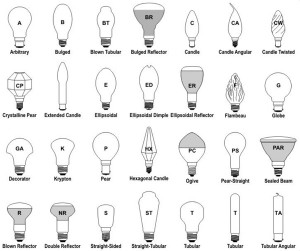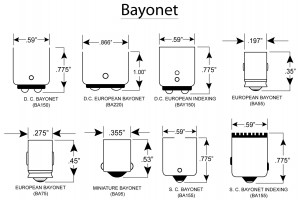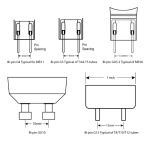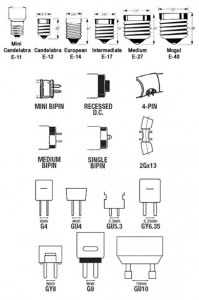
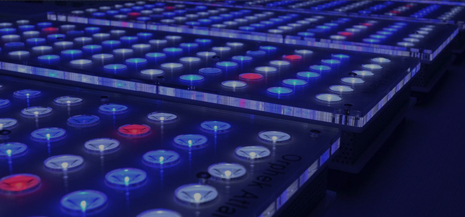

How Light Bulb Shapes Are Named
Light bulbs and lighting lamps are described by designated shape names and diameter/length codes. This usually takes a letter-number-letter format, though the last letter is optional. The leading letter(s) indicates the shape and the numbers indicate the diameter. (The final, optional letter can designate the length.)
Size is denoted by a number following the shape. In the US these numbers indicate the maximum diameter in eights of an inch. In other parts of the world this measurement is given in millimetres. For example the US bulb, R20 signifies a measurement of 20/8 or 2.5″ in diameter. Metric examples include the A19 which is a typical household incandescent light.
Sample LED Light Bulb Shape Designations:
- A Standard household incandescent light bulb shape
- B Bulged bulb shape
- BT Bulged or Blown Tubular bulb shape
- BR Short reflector style light bulb
- C Candle or Conical bulb shape
- CP Crystalline Pear bulb shape
- E Ellipsoidal bulb shape
- ER Extended reflector light bulb shape
- F Flame style candelabra bulb shape
- G Globe bulb or circular bulb
- HK Hexagonal Candle
- K Krypton or narrow reflector light bulb shape
- MB Halogen bulb
- MR Quartz reflector lamp (low wattage)
- P Pear bulb shape
- PAR Parabolic Aluminized Reflector (PAR) lamp
- PS Elongated standard incandescent bulb
- R Reflector light bulb style
- S Strait Sided bulb style
- T Tube lamp shape
Standard diameter sizes (in eights of an inch):
| Description | Inch diameter | Typical usage |
| 8 | 1″ | T8 tube |
| 11 | 1.375″ | MR11 |
| 16 | 2″ | MR16 |
| 20 | 2.5″ | PAR20 |
| 30 | 3.75″ | PAR30 |
| 38 | 4.75″ | PAR36 |
- A Shaped Light Bulbs
“A” type bulb shapes are standard house hold light bulbs. The number after the bulb shape is the number of eighths of an inch in diameter. For metric measured bulbs the number following the bulb shape is the number of millimetres at the widest point of the bulb. Standard bulb sizes include A19 for imperial measurements and A60 for a slightly smaller metric measured bulb.
- C Shaped Light Bulbs
B shaped bulbs are also known as Candelabra Light Bulbs. They have a bulged base that tapers to a rounded or pointed tip. In some bulbs the tip is bent giving the slight look of a flicking flame.
These bulbs are common in chandeliers, night lights and lower wattage applications such as holiday string lights. Typical bases for C shaped bulbs are E14.
- PAR Light Bulbs: PAR16, PAR20, PAR30 and PAR38
PAR lamps stand for parabolic aluminized reflector lamp which has reflective surface to focus the light. For LED lamps the PAR description is used to define the shape, as most do not have a reflective surface due to the directional nature of LED lamps.
Common PAR lamps include the PAR20, PAR30 and PAR38, though many other sizes exist. These can give various beam angles that can make good spot and flood lamps.
This shape is very similar to the R shape and in some cases the PAR and R are interchangeable as shapes for LED replacements.
| PAR Size | Diameter/Inches (US) |
Diameter inches | Diameter in millimetres | R Size |
| PAR-16 | 16 | 2 | 50 | R50 |
| PAR-20 | 20 | 2.5 | 63 | R63 |
| PAR-30 | 30 | 3.75 | 95 | R95 |
| PAR-36 | 36 | 4.5 | 114 | - |
| PAR-38 | 38 | 4.75 | 120 | - |
Bulb Bases and Sockets Explained
Lamps can be described in a number of ways:
- LED Light Bulb Shape
Light bulb shapes describe the general physical characteristics of the light bulb. LED light bulbs vary in shape from tube shaped bulbs to funnel or pear shaped light bulbs. These LED light bulb shapes each have a code. For example: T designates a ‘tube’, PAR signifies a ‘parabolic aluminium reflector’ and MR is used for ‘multifaceted reflector’.
- LED Bulb Diameter
The diameter of a light bulb is measured in two ways, in metric it is the number of millimetres and in imperial measure it is the number of 1/8 inch increments. The diameter for light bulb shape is measured at the point of maximum size. Examples are: T12 is 12 eights of an inch or 12/8 = 1.5 inches in diameter, PAR20 is 20 eighths of an inch in diameter or 2.5 inches, MR16 is 16 eighths = 16/8 = two inches in diameter.
- LED Bulb Length
LED light bulb length is the overall length measured, typically from electrical connection, or base, to the tip of the bulb, or in the case of T bulbs from end to end. This can be in metric or in inches or feet. In some cases the stated length may differ from the actual length like in the case of some four foot (1200mm) T8 fluorescent replacements; these may actually be slightly less in length.
- Bulb Base Types
LED light bulb base types are typically measured by type and diameter in millimetres. For example a typical Edison medium screw-in base like E27 is 27 millimetres in diameter. LED bi-pin bases, like a fluorescent tube replacement or a bi-pin MR16, are measured between the centres of each pin.
- Naming Conventions of Light Bulb Sockets and Base Types
Light bulb bases and sockets are normally defined by a letter-number-letter format, with the last letter optional. The first letter designates the shape or form of the base, the numbers represent either the width of the base or the distance between the pins. The second letter designates the number of pins or contacts on the lamp. The numbers are normally in millimetres. LED light bulb sockets and bases are manufactured to the same standards as halogen, incandescent and other traditional lights.
For example a standard European screw-in incandescent bulb has a base type of E27. E stands for Edison screw-in and the 27 means that the base is 27 millimetres.
LED light bulbs and LED lamps use the same socket designations as traditional light bulbs:
- B Bayonet Collar Base
- E Edison Screw Light Base
- F Single Pin Type Base
- G Multiple Pin Type Light Bulb Base
- K Cable Connections
- P Pre-focused Light Base
- R Recessed Contact(s) Base
- S Shell-type Light Bulb Base
- T Telephone Slide Base
- W Wedge Base
- X Special Type Lightbulb Base
Lamp Number of Pin or Contacts
- s Single Pin
- d Double or Bi-Pin Base Type
- t Triple Pin Base or Tri-Pin Base or 3 Pin Base
- q Quadruple Pin Base or 4 Pin Base
Examples of common bayonet bases in the UK are: B15d, B22

Screw-in bases, also known as Edison bases and light bulb sockets are used throughout the world.
The naming conventions include terms like medium base and candelabra base. Often they are referred to with a letter-number designation that starts with an “E” followed by the number of millimetres in diameter of the base. If your base ends in a “d” this indicates a double contact base, this is typically used for 3-way bulbs.
“E” or Edison base types, sizes and names
| Base Number | Base or Socket Name |
Diameter (mm) |
| E5 | Lilliput Edison Screw Base | 5 |
| E10 | Miniature Edison Screw Base | 10 |
| E11 | Mini-Candelabra Edison Screw Base | 11 |
| E12 | Candelabra Edison Screw Base | 12 |
| E14 | Small Edison Screw Base (supports 240V) | 14 |
| E17 | Intermediate Edison Screw Base | 17 |
| E26 | Medium Edison Screw Base | 26 |
| E27 | Medium Edison Screw Base (supports 240VAC) | 27 |
| E39 | Mogul or Giant Edison Screw Base | 39 |
| E40 | Mogul or Giant Edison Screw Base (supports 240VAC) | 40 |
G or Bi-pin light bulb base and sockets
The “G” base type of lamp and light bulb is used to designate a “pinned” base. This can include several pin types and different numbers of pins.
Designation is by letter(s)-numbers-optional letter: The first letters include “G” followed by an optional U, X, Y or Z. Next is a number that designates the number of millimetres between the centre of each pin. Finally the optional final letter designates the number of pins, no letter implies 2 pins as does a d for double. Pin number designations include: s : Single, d : Double, t : Triple for 3 pins and q : Quadruple for 4 pins.
Examples include: GU10 base type, G24q base type, or for T8 tubes G13 bi-pin.
| Type | Typical usage | Pin centre to centre | Pin Diameter |
| G4 | MR11 and other small halogens of 5/10/20 watt and 6/12 volt | 4.0 mm | 0.65-0.75 mm |
| GU4 | 4.0 mm | 0.95-1.05 mm | |
| GY4 | 4.0 mm | 0.62-0.75 mm | |
| GZ4 | 4.0 mm | 0.95-1.05 mm | |
| G5 | T4 and T5 fluorescent tubes | 5 mm | |
| G5.3 | 5.33 mm | 1.47-1.65 mm | |
| G5.3 – 4.8 | |||
| GU5.3 | |||
| GX5.3 | MR16 and other small halogens of 20/35/50 watt and 12/24 volt | 5.33 mm | 1.45-1.6 mm |
| GY5.3 | 5.33 mm | (FLAT PINS) | |
| G6.35 | 6.35 mm | 0.95-1.05 mm | |
| GX6.35 | 6.35 mm | 0.95-1.05 mm | |
| GY6.35 | Halogen various Wattage (eg. 50W/100W), various Voltage (eg. 12/24V), Common for task lighting, landscape lighting | 6.35 mm | 1.2-1.3 mm |
| GZ6.35 | 6.35 mm | 0.95-1.05 mm | |
| G8 | Halogen 100W 120V | 8.0 mm | |
| GY8.6 | Halogen 100W 120V | 8.6 mm | |
| G9 | Halogen 120V (US) / 230V (EU) | 9.0 mm | |
| G9.5 | Common for theatre use, several variants | 9.5 mm | 3.10-3.25 mm |
| GU10 | Twist-lock 120/230-volt MR16 halogen lighting of 20/35/50 watt | 10 mm | |
| G12 | Used in theatre and single-end metal halide lamps | 12.0 mm | 2.35 mm |
| G13 | T8 and T12 fluorescent tubes | 12.7 mm | |
| G23 | 23 mm | 2 mm | |
| GU24 | Twist-lock for self-ballasted compact fluorescents, since 2000s | 24 mm | |
| G38 | Mostly used for high-wattage theatre lamps | 38 mm | |
| GX53 | Twist-lock for puck-shaped under-cabinet compact fluorescents, since 2000s | 53 mm |



